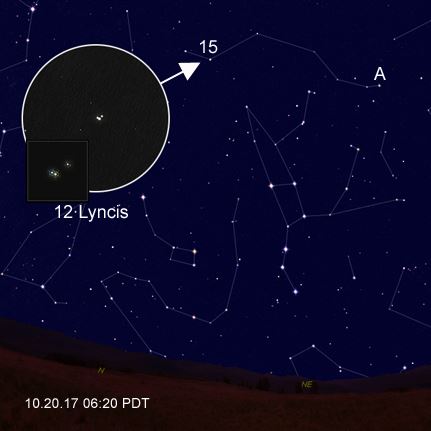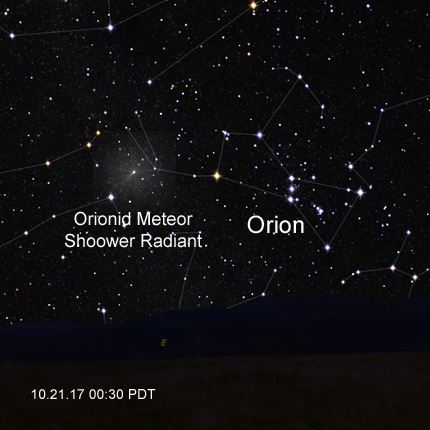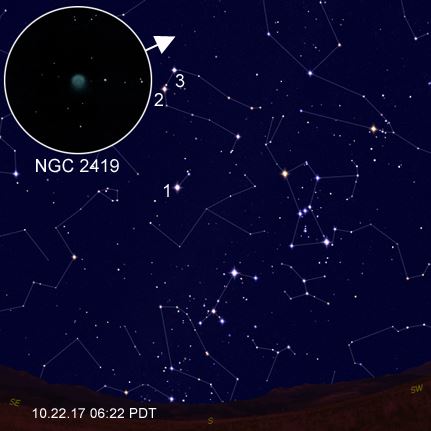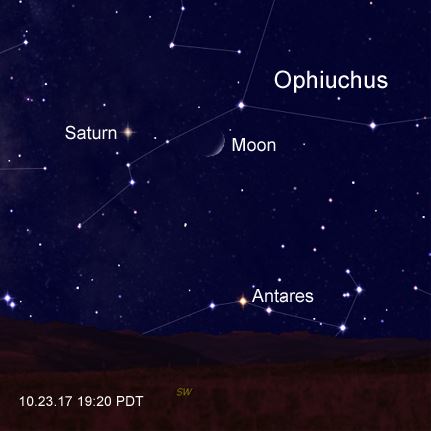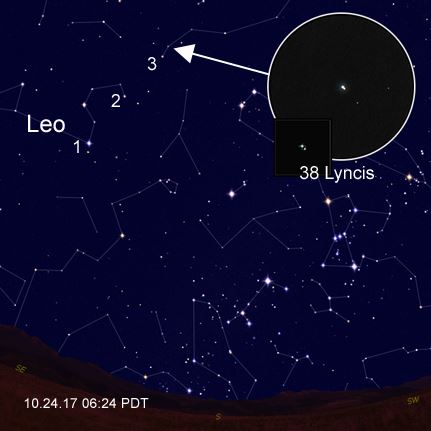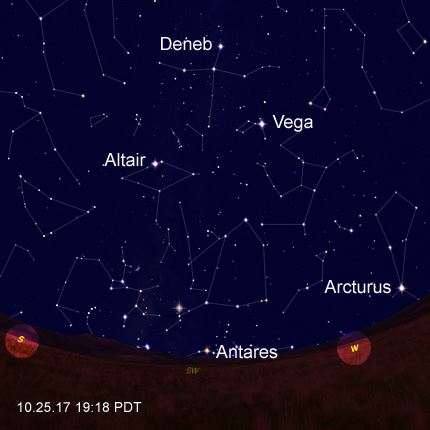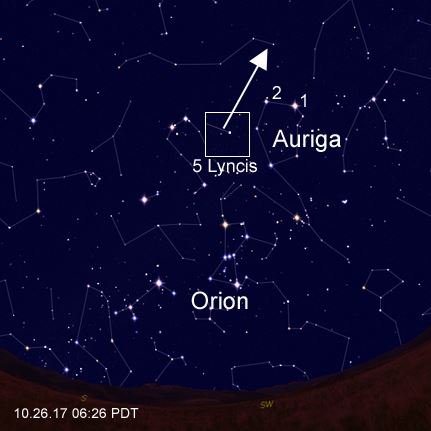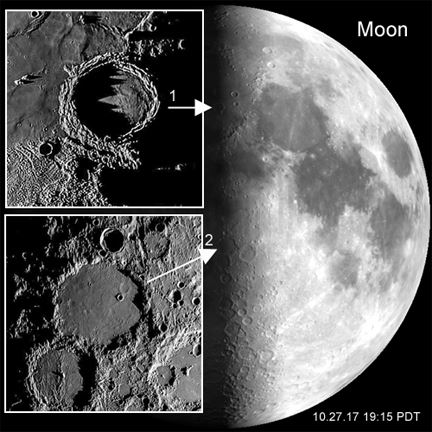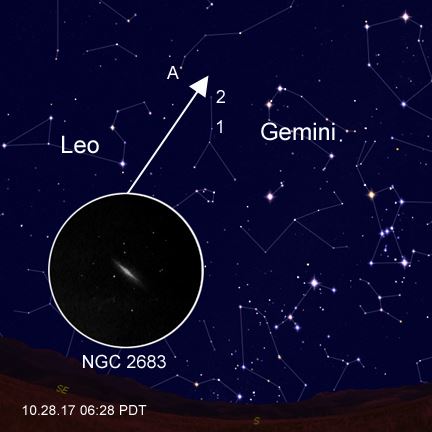The Night Sky Tonight: October 20 – October 28
By Mark Wagner
Mark Wagner brings us highlights of what's happening in the sky each night this week. Click on each image to enlarge the view. Happy gazing!
Friday, October 20
12 Lyncis is a great triple star in Lynx, a short hop from magnitude-4.34 15 Lyncis. The triple's components are a magnitude-5.44 pale yellow primary, a very close blue magnitude 6 secondary companion separated by 1.91 arc-seconds, and a dull orange magnitude-7.05 tertiary member at 9.3 arc-seconds separation. This requires high magnification, the drawing being done at 240X in a 6" f/8 Orion Newtonian. Anyone trying this, or having a prior report on it, please post in the comments of this post on our Facebook page.
Skill Level: Beginner
Suggested Gear: Orion SkyQuest XT6 Classic Dobsonian Telescope, 6mm Orion Expanse Telescope Eyepiece
After Midnight Tonight: Orionid Meteor Shower
Saturday, October 21
In the early hours of Saturday the Orionid meteor shower will reach its peak, stretching from the 2nd of October until Nov. 7. This morning's activity will be from the dusty trail remnants of Halley's Comet. "The Orionids are a medium strength shower that sometimes reaches high strength activity. In a normal year the Orionids produce 20-25 shower members at maximum. In exceptional years, such as 2006-2009, the peak rates were on par with the Perseids (50-75 per hour)."(1)
Skill Level: Beginner
Suggested Gear: Orion Star Target Planisphere, 30-50 degree, Lawnchair and your naked eyes!
Tomorrow Morning: Intergalactic Wanderer NGC 2419
Sunday, October 22
NGC 2419 in Lynx is called the Intergalactic Wanderer, a challenging object form darker suburbs. This sketch by Roger Ivester shows an unresolved hazy patch of light. Steve Gottlieb's observing notes in an 8" telescope describe it as "very faint, small, round, no resolution." At magnitude 10.4 and 6.2 arc-minutes in diameter, this object sits a whopping 275,000 light years away. Its orbit in the Milky Way takes it out past the Magellanic Cloud. Find it via Procyon (1) to Pollux (2) to Castor (3) and a short hop to zenith!
Skill Level: Advanced
Suggested Gear: Orion SkyQuest XT8 Classic Dobsonian Telescope, Orion SkyQuest XT12i IntelliScope Dobsonian Telescope
Tomorrow Evening: Moon and Saturn
Monday, October 23
Low over the southwest horizon is a visual treat you need only your eyes to view. A waxing crescent Moon just under four days old sits directly over horizon-hugging Antares, with Saturn just to its left. The Moon is in the constellation Ophiuchus, referred to as the 13th sign of the Zodiac.
Skill Level: Beginner
Suggested Gear: Orion Star Target Planisphere, 30-50 degree, Orion DeepMap 600 Folding Star Chart
Tomorrow Morning: Double Star 38 Lyncis
Tuesday, October 24
38 Lyncis is an easy magnitude 3.81 double star in Lynx, with a mag 3.9 white primary and rusty companion at magnitude 6.6 separated by a tight 2.7 arc-seconds. The pair split nicely at moderate power (100X) in 60mm-70mm telescopes. This binary pair is 124 light years from Earth, and actually part of a sextuple star system, five being visible. I find an easy hop from Regulus (1) in Leo, to Epsilon Leonis (2) then Alpha Lyncis (3).
Skill Level: Beginner
Suggested Gear: Orion Observer II 70mm Equatorial Refractor Telescope, Orion StarBlast 4.5 Astro Reflector Telescope
Tomorrow Evening: See Summer Setting
Wednesday, October 25
As Fall deepens in the northern hemisphere, we can see in the sky that Summer is truly waning. All the well-known summer stars are close to or past due south, and heading toward the western horizon as twilight fades into night. Time to get your cold weather gear ready for the great sights of the chilly autumn and winter nights!
Skill Level: Beginner
Suggested Gear: Orion Star Target Planisphere, 30-50 degree, Orion DeepMap 600 Folding Star Chart
Tomorrow Morning: Binocular Triple Star in Lynx
Thursday, October 26
5 Lyncis is not a physical double (binary) star, but it is a nice sight in binoculars or small telescopes. The primary member of this triple star system is a magnitude-5.3 yellow star separated by 31.4 arc-seconds at P.A.139 from its magnitude-9.8 blue companion. That's a large magnitude difference, so it will be challenging. The third member is magnitude 7.9 and 96 arc-seconds away at P.A. 272. If P.A. is a mystery, it stands for position angle. Would someone explain position angle for us? Leave a comment on this post on our Facebook page. Hop to this star above Orion and Auriga—from Capella (1) to Beta Aurigae (2), right angle up about twice the distance.
Skill Level: Intermediate
Suggested Gear: Orion SpaceProbe 130 EQ Reflector Telescope, Orion SkyQuest XT6 Classic Dobsonian Telescope
Tomorrow Evening: Can't-Miss First Quarter Moon Targets
Friday, October 27
What great targets on tonight's First Quarter Moon terminator! Archimedes (1) is a 6,300 foot tall, 50-mile diameter crater best viewed in instruments 50mm on up. Look for steep slopes, terraced walls and a very flat floor filled with lava and craterlets. Dynamic relief of the shadows should be superb tonight. Ptolemaeus (2) anchors a chain of large craters including Alphonsus and Arzachel descending along the terminator toward the southern pole. 93 miles in diameter it will show a very flat floor with high walls. Just cruise the chain in 10X binocular on up. Enjoy!
Skill Level: Beginner
Suggested Gear: Orion Scenix 10x50 Wide-Angle Binoculars, Orion AstroView 90mm Equatorial Refractor Telescope
Tomorrow Morning: Deep Sky Challenge NGC 2683
Saturday, October 28
NGC 2683 is a fine target for 8 and 10 inch telescopes. At magnitude 10.50 and a large 8.4x2.4 arc-minutes in size, this edge-on galaxy will appear highly elongated with a slightly brighter and highly elongated core. Located near Alpha (A) Lyncis between Leo and Gemini, you can use the dim pointer stars (1 and 2) in Cancer to get to it. This galaxy is 30 million light years from our host star, receding from us at 250 miles per second. William Herschel discovered it in 1788, and it was later nicknamed the "UFO Galaxy." Go identify it!
Skill Level: Intermediate
Suggested Gear: Orion SkyQuest XT10 Classic Dobsonian Telescope, Orion SkyView Pro 8" Equatorial Reflector Telescope
Tomorrow Evening: Moon and Fomalhaut
Charts from Starry Night Pro, available from Orion Telescopes & Binoculars. 12 Lyncis and 38 Lyncis sketches from Jeremy Perez's Belt Of Venus Blog. (1) - American Meteor Society. NGC 2419 and NGC 2683 sketches by Roger Ivester. Moon images courtesy Robert Reeves.
Mark Wagner is a lifelong astronomy enthusiast and deep sky observer in the San Francisco bay area. Visit our Facebook Page if you'd like to post comments, questions, sketches or images you've taken to our Night Sky Tonight post.
sales and new products.

 English USD
English USD
